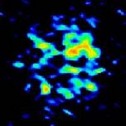According to a report from Space.com on April 7, 2005, the rebirth of an old star named V4334 SGR in the constellation Sagittarius, which was observed by using National Science Foundation's Very Large Array (VLA) radio telescope, has surprised researchers by flying through the process 100 times faster than predicted. The surprising rebirth forced researchers to produce new models of how such an old, white dwarf star could re-ignite its nuclear furnace for one final blast of energy.
 |
| VLA radio image of V4334 SGR. (American Association of Variable Star Observers) |
The star is a white dwarf, an aged Sun-like star that has used up its nuclear fuel and collapsed. A teaspoon of its material would weigh about 10 tons here on Earth. The star is better known as "Sakurai's Object," after Japanese amateur astronomer Yukio Sakurai, who discovered it on Feb. 20th, 1996, when it suddenly became bright. It's the first such outburst observed in modern times. Stellar outbursts observed in 1670 and 1918 may have been caused by the same phenomenon. At first, astronomers thought the outburst was a common nova explosion, but further study showed that Sakurai's Object was anything but common.
Astronomers think a white dwarf's final eruption involves a burst of fusion in a shell of helium that surrounds a core of heavier nuclei such as carbon and oxygen. Computer simulations had predicted a series of events that would follow such a re-ignition of fusion reactions, but the star didn't follow the script - events moved 100 times more quickly than the simulations predicted. Namely, V4334 SGR went through the first phases of this sequence in just a few years - 100 times faster than it was expected. Astronomers are taking advantage of a once-in-a-lifetime opportunity to watch V4334 SGR's evolution. Astronomers presented their findings in the April 8th issue of the journal Science.
Reference:
http://www.space.com/scienceastronomy/050407_old_star.html
http://www.spacedaily.com/news/stellar-chemistry-05n.html
* * *
You are welcome to print and circulate all articles published on Clearharmony and their content, but please quote the source.










 more ...
more ...